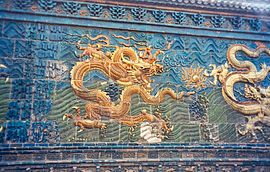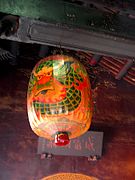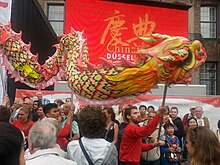Long (mythology)
| Long | |
|---|---|

|
|
| Chinese name | |
| Long characters | 龍 |
| Abbreviation | 龙 |
| Pinyin (Mandarin) | lóng |
| Jyutping (Cantonese) | ment 4 |
| Vietnamese name | |
| Quốc Ngữ | rồng, long |
| Hán tự | 龍 |
| Korean name | |
| Hangeul | 1. 룡 / 용 2. 미르 |
| Hanja | 龍 |
| Revised Romanization | 1st ryong / yong 2nd mileu |
| Japanese name | |
| Kanji | 龍 |
| Shinjitai | 竜 |
| Rōmaji | 1. ryū 2. tatsu |
Lóng is the name of the Chinese dragon . He is considered to be the most famous mythical creature in China and the entire East Asian cultural area.
Origin and meaning
The creature that occurs frequently in Chinese mythology , in contrast to European dragons, can be compared more with a deity than with a (malicious) demon . The dragon or the various local dragon deities (in rivers, lakes, bays, according to a legend even in fountains) are still worshiped today, especially in rural areas, to ask for rain, for example. Not all dragons were benign, however. Was feared u. a. the black dragon of the flood, responsible for floods and storms.
The first occurrence of the dragon motif together with the Fenghuang , a Phoenix -like Vogel, comes from China Warring States Period (480-221 v. Chr.). The dragon and Fenghuang were originally the symbol of the imperial couple for heaven and earth. There, the symbol met the Mongols conquering China, who took it over and brought it to the Far and Middle East with their further expeditions of conquest. For the art of the Middle East, the dragon motif was an innovation of the 13th century. One of the first examples of the adoption of the motif can be found on an inlaid metal basin in northern Syria. From this point on, the dragon and Fenghuang motif can be found in stylized form on carpets.
In Chinese mythology there are two types of dragons, the water dragons, who represent deities of the waters, and fire dragons . Although they do not differ externally, their character is completely different: the fire dragon fears the water, while the water dragon fears the fire. There are, for example, fairy tales according to which an evil fire dragon was killed by water.
The fire dragon is also the “pet” of the Chinese fire god Zhurong (not to be confused with the historical Man queen of the same name). He is scaled red and is breathing fire. There are also ice dragons that were very helpful to the Monkey King Sun Wukong on his pilgrimage to India (for example by cooling the hot water of saucepans in which the monkey master - the monk Xuanzang - was to be cooked by demons ).
The most important dragon god is the dragon emperor of the Eastern Sea ( Ao Guang ), who was surrounded by a fantastic court of (sea) animal spirits , who represented people with animal heads rather than animals (e.g. General Shrimp ). He is famous for his magical weapons, among other things, which attracted the attention of the Monkey King Sun Wukong. He was also revered as a rainbringer. There are also dragon kings ( Long Wang ), in the seas of the west, north and south. Ao Guang, however, is the most prominent dragon ruler, and very famous for his acquaintance with figures like Nezha and Sun Wukong (although he was also ridiculed by the latter).
With the arrival of Buddhism , the benevolent aspects of the dragon were sometimes altered and aligned with the more malevolent naga , but this is not the case with the Long Wang.
Appearance
The appearance of the dragon can be described as follows: the body is that of a mighty snake, the scales that of a carp, the head resembles that of the water buffalo with a mane, the beard and the two slightly longer beards on the nose, the four, are also striking Legs (with varying number of toes, depending on the rank of the being) correspond to those of the eagle . A red scalloped comb runs along the back, like the European kite. In addition, deer antlers rise from the head. The dragon's teeth are more like those of a mammal than a reptile (there are incisors , canines , etc.). It is therefore more like the jaw of a wolf or lion. A kind of beard sprang from the nose, the base of the neck and the lower jaw.
However, the dragon can also take other forms. There is a saying in China: the dragon has nine sons, each of them is different. The turtles that carry the stone tablets in the temple ( bìxì ) and the lions on the curved roofs ( chīwěn , cháofēng ) are also forms of dragons according to the Chinese interpretation. As a magical being, the dragon is usually able to take on other forms, including human form. There are also said to be magical objects, mostly in the form of a pearl (the dragon pearls ), that humans can turn into dragons if someone swallows them.
In Korea the dragon ( yong ) is represented with four claws, in Japan ( ryū ) with three claws. In Chinese legends it is said that the further away the dragons travel from their land, the more claws they lose. In Japanese legends it is exactly the opposite, the further they travel, the more claws they grow.
Cultural meaning
The dragon is used as a symbol in many ways:
- The dragon was a symbol of the Chinese emperor , the Chinese imperial throne is also called the dragon throne . The imperial dragon had five claws and was reserved for the emperor and his highest officials. The depictions of dragons on the clothing of lower-ranking officials had four or three claws depending on the hierarchy. It was forbidden to all subjects on the death penalty to use the symbol of the imperial dragon.
- The Divine General Mo Lishou , who guards the north, also has a dragon, or rather, a kind of mythical snake . It causes thunder. The four Divine Generals are Buddhist gods and are derived from the four diamond kings of Buddhism. They all have the family name "Mo".
- In Chinese numerical symbols, the nine stands for the dragon.
- It is the 5th of the 12 branches of the earth on the Chinese calendar . For example, 2000, 2012 and 2024 are years of the dragon. He is the only mythical being in the Chinese horoscope.
- China is often equated with the dragon. It has been a symbol of the Chinese state since the Qin Dynasty . The flag of the Qing Dynasty is also adorned with a blue dragon with five claws.
- According to a legend, the Chinese see themselves as descendants of the dragons ( Long de Chuan Ren ).
- In Fengshui certain geographical features (mostly rivers or long mountains) are interpreted as dragons. The position and orientation of buildings are adapted to the position of the kite, whereby particular care is taken not to “block the kite's view”.
- In China there is also the tradition of the dragon dance.
Web links
- Mark Schumacher: Dragons, Dragon Art, and Dragon Lore in Japan Buddhism and Shintoism. September 5, 2006
Footnotes
- ↑ Volkmar Enderlein in the guide sheet No. ISL 2 of the Pergamon Museum 1994
- ↑ http://www.asianartmall.com/dragonarticle.htm
- ↑ Josef Guter: Lexicon of the gods and symbols of the ancient Chinese. , P. 66
- ↑ Harald Gebhard, Mario Ludwig: Of dragons, yetis and vampires. BLV Buchverlag 2005, ISBN 3-405-16610-1 , p. 47.





